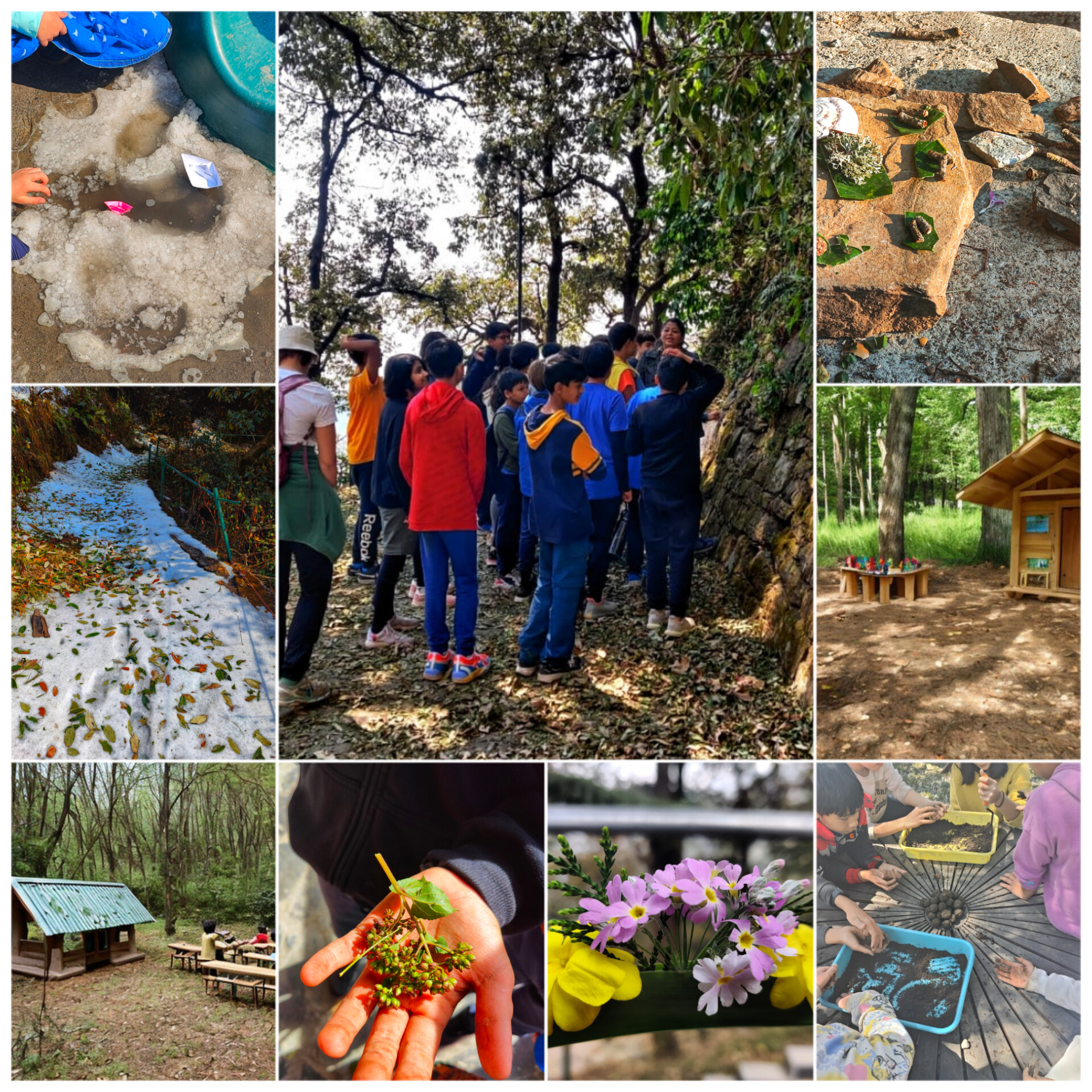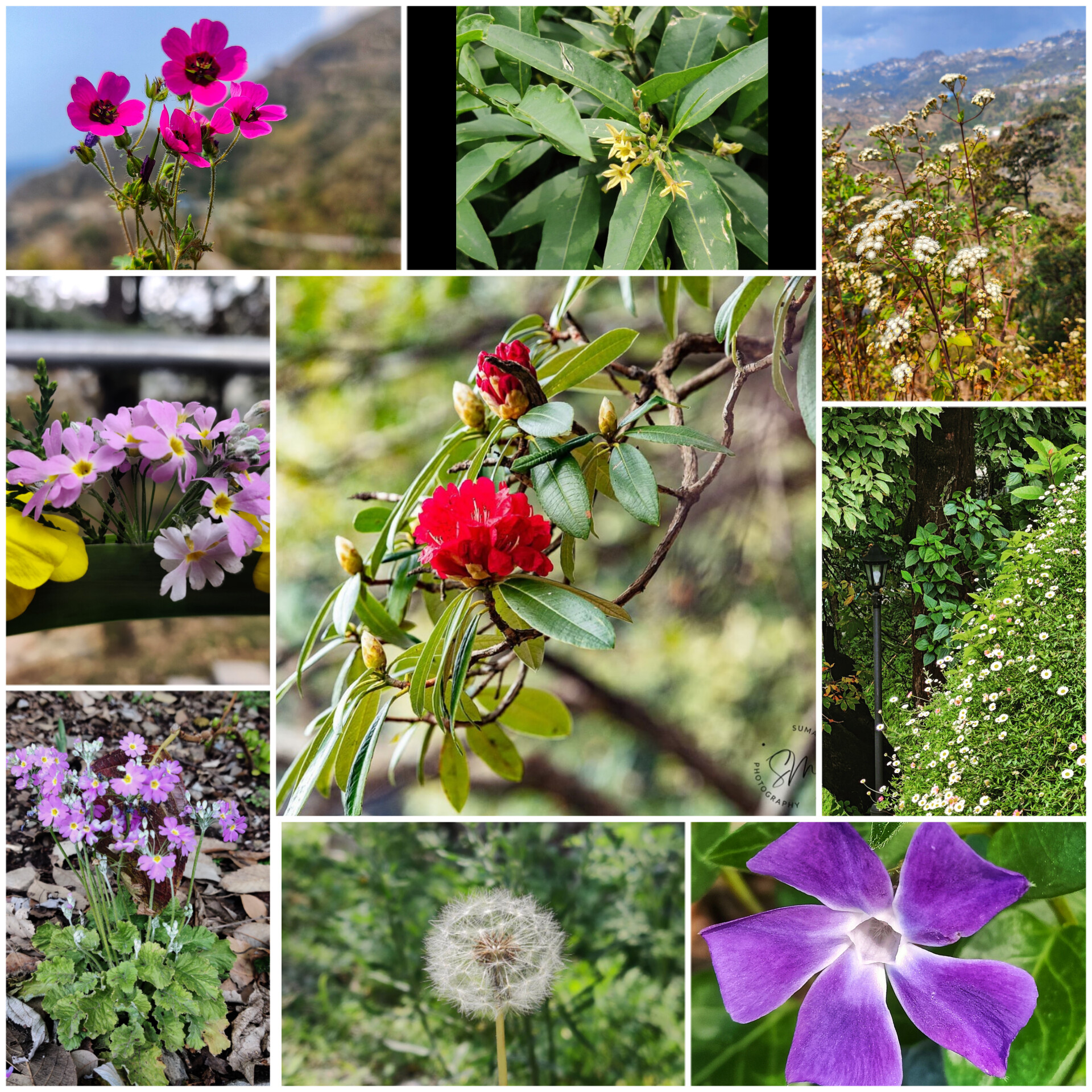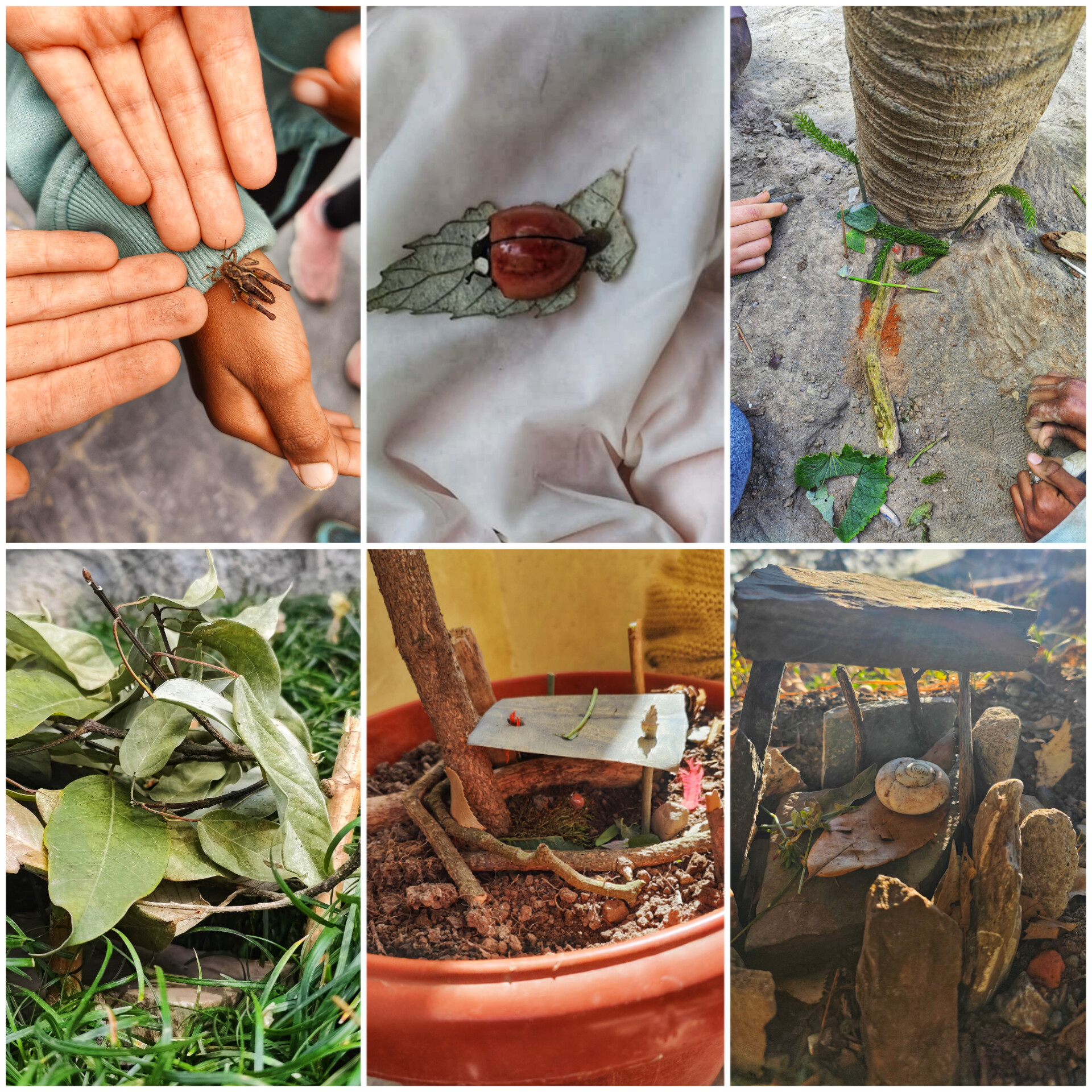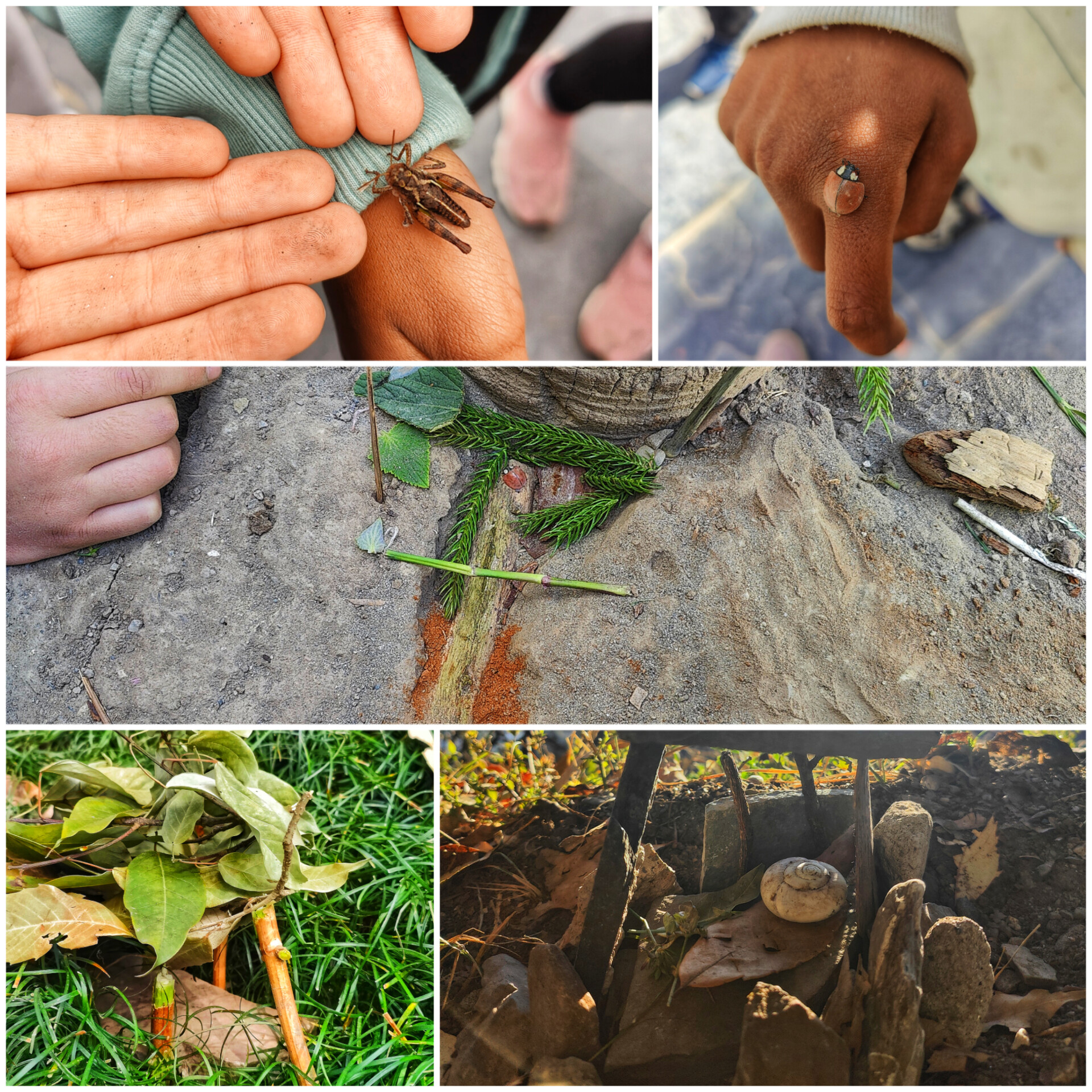As technology continues to advance, children are spending more and more time indoors. As a result, outdoor education has become more important than ever. Outdoor learning provides a unique opportunity for children to connect with nature, learn new skills, and develop a deeper appreciation for the environment. But before beginning the experience of outdoor learning there are few key considerations and measures which must be entailed during the lessons. In this post we discuss about reflection questions based on Chapter 3 of the book ‘Dirty Teaching by Juliet Robertson. The chapter is about getting started class outdoors and aims towards acclimatizing to the process of learning outside. Based on the ideas and concepts mentioned in the text, following are few discussion questions along with extended illustrations. 1. What are some key considerations when planning and conducting the first few lessons in outdoor education? a. Safety: Before planning any outdoor education lessons, it is important to research and assess the potential risks and hazards associated with the location and activity. It is essential to prioritize the safety of all participants and ensure that proper safety measures and equipment are in place. b. Goals and Objectives: Identify the learning goals and objectives for the first few lessons. These can range from team-building and leadership skills to scientific inquiry and environmental education. Having a clear understanding of the desired outcomes will help guide the lesson planning and ensure that all activities are aligned with the objectives. c. Equipment and Resources: Ensure that all necessary equipment and resources are available, including appropriate gear for the activity, first aid kits, and any educational materials or tools needed to support the learning goals. d. Assessment and Evaluation: Develop appropriate methods for assessing and evaluating student learning, including pre-and post-assessments, ongoing observations, and student self-reflections. This will help teachers to understand student progress and adjust lessons as needed. e. Collaboration and Communication: Effective communication is essential for planning and implementing successful outdoor education experiences. Teachers should work collaboratively with other educators, administrators, and community partners to ensure that all stakeholders are informed and engaged in the process. Open lines of communication with students and families will also be critical for ensuring that all participants feel prepared and supported throughout the experience. 2. What techniques or strategies can you use to create a safe and positive learning environment for students in an outdoor setting? a. Set clear expectations: Establish clear expectations for behavior and safety. Discuss the rules and expectations ahead of time and provide reminders as needed. b.Foster teamwork: Encourage teamwork and collaboration among students. Activities that promote teamwork can help students develop respect and empathy for each other. c. Create a welcoming atmosphere: Create a welcoming atmosphere that is friendly, safe, and inclusive. Make sure that everyone feels comfortable and welcome. d.Encourage student ownership: Encourage students to take ownership of their learning experiences. Allow students to have input into the activities and lessons in order to feel more invested in their learning. e. Model positive behavior: Model positive behavior by demonstrating respect, consideration, and kindness towards all students. Teachers should model appropriate behavior and provide feedback to students when appropriate. f. Emphasize safety: Emphasize safety both in terms of physical safety (e.g. wearing appropriate clothing and keeping track of students) and emotional safety (e.g. ensuring that students feel valued and respected). g. Provide a variety of activities: Provide a variety of activities and challenges to keep students engaged and motivated. Make sure that these activities are age-appropriate and suit the needs and interests of the students. h. Use positive reinforcement: Use positive reinforcement to encourage positive behavior. Provide praise and recognition for students who follow expectations and demonstrate positive behavior. 3. How can you engage students’ curiosity and interest in the natural world through your first few lessons in outdoor education? a. Start with a Nature Walk: Going on a nature walk is a great way to get students excited about the natural world. Encourage them to look for interesting plants, insects, and animals as they walk around. Ask open-ended questions and foster a sense of curiosity about what they are seeing. b. Introduce Local Flora and Fauna: Introducing students to the local flora and fauna is key in getting them interested in the natural world. Discuss some of the plants and animals they might encounter during their outdoor education experience. For example, you could talk about the types of birds, reptiles, or mammals that are common in your area and explain their behaviors and characteristics. c. Incorporate Hands-On Activities: Hands-on activities are great for getting students engaged in their learning. Plan activities that allow students to touch and interact with nature, such as tree identification walks or creating a nature art project. d. Share Personal Experiences: Sharing personal experiences about the natural world can help students connect to the content. Talk about your favourite outdoor memory, share stories of times when you see an animal in its natural habitat, or explain how a certain plant is used in your culture. e. Use Technology: Technology can be used as a tool to enhance outdoor education experiences. Use apps like iNaturalist or Seek by iNaturalist to help students identify plants and animals, or use GPS devices to track students’ progress as they explore the natural surroundings. 4. What are some important skills or knowledge areas that you want to convey in the first few lessons of outdoor education, and how can you effectively teach these concepts in an outdoor setting? a. Safety and Wilderness Survival Skills: Most important aspect of outdoor education is safety. Students should learn how to identify and prevent potential hazards such as falling, cuts, insect bites or even threatening wildlife encounters. One way to teach safety and wilderness survival skills is through interactive scenarios and role-plays. For example, students can learn how to build a shelter, start a fire, gather and purify water, and navigate using a map and compass. b. Natural History and Ecology: Outdoor education can help students develop a
A Floral Paradise: Spring Blossoms in the hillside of Landour, Mussoorie
The hillside of Landour, Mussoorie is again alive with the colors of spring. Springtime in the hills of Landour, Mussoorie is simply enchanting. The beauty of nature is at its peak, with the hillside covered in a vibrant display of blossoms. From the magnificent rhododendrons to the delicate myrtles, geraniums and primulas, the colors of spring are truly breathtaking. As the sun shines down on the hillside, the flowers light up like a kaleidoscope. A nature walk in spring is a beautiful and invigorating experience. As you take a nature walk along the winding paths, you’ll be mesmerized by the beauty of nature in full bloom. The hills and valleys are carpeted with flowers, the fresh mountain air and the sounds of birds will rejuvenate your senses. The hillside of Landour in spring is a haven for nature lovers and amidst the beauty of nature. The colorful blooms of spring will leave you spellbound and create memories that will last a lifetime. Although Mexican Devil is considered an invasive species, it was originally planted as an ornamental plant. The spring season in Landour is a perfect time to experience the natural beauty. I hope you enjoyed reading about the spectacular spring blossoms in Landour, Mussoorie. Witnessing the beauty of nature during the spring season is truly a mesmerizing experience. Like, share and follow. ? https://www.facebook.com/Dr.ChandrimaDebi/ https://youtu.be/kwrnWPwOI7E https://www.instagram.com/debichandrima/ https://www.sumanmitra.com/ https://linktr.ee/chandrimadebi ©All images and content are subjected to copyright © 2023 chandrimadebi https://chandrimadebi.com
Weeding invasive Mexican Devil (Ageratina adenophora) in the hillside: Nature based learning and outdoor education activity
Mexican Devil (Ageratina adenophora synonym Eupatorium adenophorum), commonly known as Crofton weed, is a species of flowering plant in the family Asteraceae native to Mexico and Central America. Initially grown as an ornamental plant, it has now become invasive into forests, hillslopes, roadside and farmlands. It forms dense colonies and prevents the seedlings of native species from establishing in a wide range of habitats. This invasive species is a serious problem in the hillside, as it is slowly replacing vulnerable species and limiting growth and development of various other important plant species. Locally known as Kala bhasa, it changes the microbial composition which hampers the growth of local plants, thus forming dense mono cultures and reducing the native biodiversity. Such an invasion of alien species is recognized by the International Union for Conservation of Nature(IUCN) as the second greatest agent of species endangerment and extinction, after habitat destruction. There is an immediate need to prevent dispersal of seeds during the months of March?April, as flowers are in full bloom. Mechanical weeding out the plant by uprooting and burning the entire plant (with roots) seems the most viable method. The control of the invasive species is achievable through continuous and diligent effort, year after year. In this regard, students carried out mass weeding out activities in the hillside through nature-based learning. It is a form of environmental education that focuses on the study of forest ecology and the use of natural processes to help with weeding out unwanted plants in the forest. It is an effective way to teach students about the importance of conservation, while also helping them understand how invasive plants can cause harm to our forests. By understanding the ecology of a forest, students can learn how to identify and remove invasive plants from their environment. Nature-based learning can also help us better understand our role in protecting our forests from destruction caused by human activities. Nature based learning activities can be a great way for kids to learn about ecology and identify unwanted plants. By engaging in outdoor learning activities, children can develop an understanding of the environment and its importance to their own lives. Through hands-on exploration, they can gain knowledge about different types of plants, their characteristics, and how they interact with each other. Additionally, they can learn to identify weeds and understand why it’s important to remove them from gardens or landscapes. Nature based learning activities are a fun way for kids to explore the outdoors while gaining valuable knowledge about ecology and weed identification. Involving children in conservation efforts is a great way to help protect the environment. By getting children involved in weeding out unwanted plants in the forest, they can learn about the importance of protecting our natural resources and how their actions can make a difference. Not only does this help to keep our forests healthy, but it also provides children with an opportunity to learn about nature and how they can contribute to its preservationInvolving children in conservation efforts also helps to instill values such as respect for nature and responsibility towards our planet. This knowledge can then be passed on from generation to generation, helping ensure that future generations are aware of their role in preserving the planet’s resources. I hope you enjoyed the article about the issue of invasive Mexican Devil (Ageratina adenophora) in the hillside. I have found many success stories of students who have used learning activities to get their hands dirty and learn about invasive species in their natural environment. If you or your students need help with any of these topics, I would be happy to help out! Please let me know if you have any questions or comments. I will be glad to hear from you! If you would like to know more about invasive species, visit the site at www.chandrimadebi.com Thank you for reading. Like, share and follow. ? https://www.facebook.com/Dr.ChandrimaDebi/ https://www.instagram.com/debichandrima/ https://www.sumanmitra.com/ https://linktr.ee/chandrimadebi ©All images and content are subjected to copyright © 2023 chandrimadebi https://chandrimadebi.com
Building a Home for Bugs: The Educational Benefits of Insect Houses in Early Childhood Education
Insects play an essential role in our ecosystem, and early childhood is the perfect time to teach children about their importance. By building insect houses, children can experience the joy of creating a home for these tiny creatures and learn about their habits and behaviors. Moreover, insect houses can help young children learn about sustainability, ecology, and the interconnectedness of nature. In this post, we will explore the educational benefits of insect houses in early childhood education and how they can help children develop their cognitive, social, and emotional skills. We will also provide a step-by-step guide to building your own insect house, so you can get started on this fun and educational activity with your little ones! An insect house, also known as a bug hotel, is a specially designed structure made to provide shelter and nesting sites for a variety of insects. These structures can be made from a variety of materials, such as wood, bamboo, and even recycled materials, and can be placed in gardens, parks, schools or even private homes. Insect houses are important because they provide a safe and comfortable environment for insects to live, and they also offer an excellent opportunity for children to learn about the natural world.Insects play a vital role in our ecosystem, from pollinating plants to breaking down organic matter. By providing them with a habitat, we can help to support their populations and ensure that they can continue to perform these important functions. In addition, observing and learning about insects can help develop children’s curiosity and understanding of the natural world. Insect houses can be used as a tool to teach children about different insects, their habitats, and their behaviors in a fun and interactive way. By building and maintaining insect houses, children can also learn about the importance of conservation and the role they can play in protecting the environment. In this blog post, we will explore the educational benefits of insect houses in early childhood education and provide tips on how to build and maintain your own insect house. Insect houses can have a multitude of benefits in early childhood education. Firstly, they provide a hands-on learning experience for young children, allowing them to explore the natural world and learn about the different types of insects and their habitats. This can be a fun and engaging way to introduce children to science and biology, as they observe the behavior and characteristics of the insects that visit their insect house.In addition, building and maintaining an insect house can help to teach children about the importance of environmental conservation and the role that insects play in our ecosystem. By creating a safe and welcoming haven for insects, children can learn about the interconnectedness of different species and their importance in maintaining a healthy and balanced environment.Moreover, insect houses can also help to promote creativity and imagination in young children. They can be decorated and customized in a variety of ways, allowing children to express themselves artistically while also learning about the natural world around them.Overall, insect houses can provide a range of educational benefits for young children, from hands-on learning experiences to lessons about environmental conservation and creativity. By incorporating them into early childhood education, educators can create a fun and engaging learning environment that encourages curiosity and exploration. One of the biggest benefits of insect houses in early childhood education is the hands-on learning opportunities they provide. Children learn best through hands-on experiences, and insect houses can provide numerous opportunities for children to engage with their environment and the insects that live within it.When children build or observe insect houses, they learn about the insects themselves, their habitats, and their roles in the ecosystem. This type of experiential learning helps to build a deeper understanding and appreciation for the natural world.Additionally, building insect houses can help children develop important skills such as critical thinking, problem-solving, and creativity. As children work to design and construct the perfect insect house, they must use these skills to determine the best materials and design elements to include.Overall, insect houses are a valuable addition to any early childhood education program, providing a fun and engaging way for children to learn about the natural world while developing important skills that will serve them throughout their lives. Insect houses are a great way to encourage curiosity and exploration in early childhood education. By providing a home for bugs, children are able to observe and interact with insects in a safe and controlled environment. This can spark a child’s natural curiosity about the world around them and can lead to questions and discussions about the different types of insects that they encounter.In addition, exploring the insect house can be a fun and engaging activity that encourages children to use their senses. They can observe the insects up close, listen to the sounds they make, and even touch them (if they are safe to do so). This hands-on experience can help children to develop their observation and exploration skills, and can also help them to develop a deeper appreciation and respect for the natural world.Furthermore, insect houses can be used as a tool to teach children about the role that insects play in our ecosystem. By learning about the different types of insects and their behaviors, children can begin to understand how insects contribute to the balance of nature and the importance of preserving their habitats. This can help to instill a sense of environmental responsibility in young children and can help to foster a lifelong love of nature. Insect houses are a fantastic way to introduce children to the concept of ecosystems and the environment. By building a home for bugs, children can learn about the different habitats that insects live in and the important role they play in the larger ecosystem. They can explore the different types of insects that live in the insect house and learn about the food that they eat, the shelter they need, and the beneficial role they play in
Making insect house: Nature based learning in early childhood education
Insects are an important part of any ecosystem, and children can learn a lot about them by observing them and providing them with a habitat in which they can live. A child’s natural inclination to build things can be put to good use in creating a home for insects. In this regard, nature-based learning is a great way for children to learn about the world around them. One way to do this is to have them build a home for insects. This is a great way to learn about insects, as well as the different types of homes they can live in. It is also a great way to learn about architecture, engineering, and construction. Children can experiment with making a home for insects with different building materials available in nature. The child can choose the type of insect they want to house, and then research what kind of home would be best suited for that insect. They can then experiment with making the home, and see which design works best. It’s also a wonderful experience to observe children displaying various psycho- social behaviours where they were responsible towards nature as well as themselves. The activity also builds risk taking and leadership skills in the children. In the photograph below, students first figured that they want to put a stone slab as roof for the insect house, but gradually they discussed among themselves that the heavier weight of the slab might crush the little insect, so they collectively suggested to put a lighter shade over the house structure. The female children prefer decorating their houses with molluscs and flowers too. They were also keen on the comfort and safety of the little insect inside. They can then build the home, or help to build it, and place the insect inside. This can be as simple as a small container with some sticks and leaves, or as elaborate as a full-sized house. There are a number of ways to go about this. One option is to provide a simple container such as a cardboard box or a plastic bottle and let the children decorate it with leaves, twigs, and other natural materials. They can then make small holes in the container for the insects to enter and exit. Another option is to build a more elaborate structure, such as a small house or even a garden. This can be done with materials such as sticks, stones, and leaves, and the children can help create a little ecosystem inside, complete with a pond, a tree, and even a small cave. Insect homes can come in many different shapes and sizes. Some of the most common types of homes include: -Homes made from sticks, leaves and moss-Homes made from mud or clay-Homes made from wood-Homes made from glass Each type of home has its own advantages and disadvantages. For example, homes made from sticks and leaves are easy to make, but they can be easily destroyed by wind or rain. Homes made from mud or clay are very sturdy, but they can be difficult to clean. Homes made from wood are easy to clean and maintain, but they can be damaged by insects. Insect homes can be made from a variety of different materials, including Sticks, Leaves, Mud or clay, Wood, Moss or grass, Rocks or stones, pebble etc. Each material has its own benefits when it comes to making insect homes. For example:-Sticks are easy to find and can be used to create a variety of different homes-Leaves or moss can be used to create a quick and easy home for insects-Mud or clay can be used to create a sturdy home that can withstand the elements-Wood can be used to create a warm and comfortable home for insects-Glass can be used to create a transparent home that allows insects to be easily observed. There are many benefits to nature based learning for early years children. Some of these benefits include:-Nature based learning helps children learn about their environment and the world around them-Nature based learning helps children develop a sense of wonder and curiosity about the world-Nature based learning helps children learn about science and nature-Nature based learning helps children develop a love of nature and the outdoors-Nature based learning helps children develop a sense of creativity and imagination All of these benefits are important for early years children as they help them to learn, grow, and develop in a variety of important ways. The children also learn a lot about insects and their habits, and they will also have the satisfaction of knowing that they have created a home for these important creatures. In early childhood education, there are many ways to incorporate the natural world into learning. Whether your children are in preschools, summer camps, or in other early-child development settings, nature is one of the many ways to promote learning and development. I hope you enjoyed the article about how you can use nature to inspire learning. If you would like to read more about nature-based learning, you can visit my website at www.chandrimadebi.com Thank you for reading, we hope you enjoyed the article! Like, share and follow. ? https://www.facebook.com/Dr.ChandrimaDebi/ https://www.instagram.com/debichandrima/ https://www.sumanmitra.com/ https://linktr.ee/chandrimadebi ©All images and content are subjected to copyright © 2023 chandrimadebi https://chandrimadebi.com






